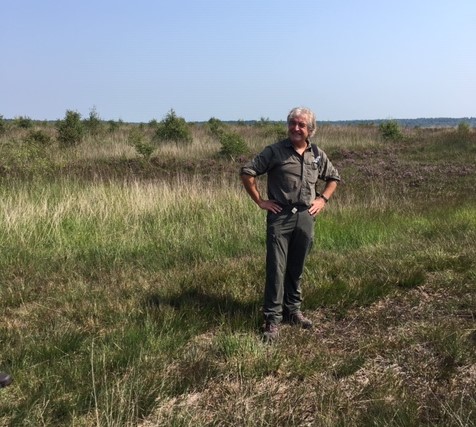Tony Juniper Visits Nature Recovery in Action at Marches Mosses BogLIFE Project
November 3, 2020
Tony Juniper, Head of Natural England, had the opportunity to see nature recovery in action when he visited the BogLIFE project at Marches Mosses earlier this year.

The BogLIFE team gave Tony a tour of the innovative £5 million project to revitalise Fenn’s, Whixall, Bettisfield, and Wem Mosses SAC and NNR, Britain’s third-largest lowland raised bog. The Marches Mosses BogLIFE project is a five-year project to restore this Shropshire peatland and contribute to the Government’s peatland restoration goals in the 25 Year Environment Plan. This work is being funded by the European Union’s LIFE Nature and Biodiversty Programme and the National Lottery Heritage Fund. It is a cooperative scheme that includes Natural England, Natural Resources Wales and the Shropshire Wildlife Trust.
The site covers 2500 acres, and this project is working to restore 650ha (1,600 acres) of degraded, carbon-emitting peat into a functioning bog, not only restoring the amazing biodiversity but also regulating water quality and flow, preventing carbon emissions and providing future carbon sequestration.
The project has many unique elements and challenges, especially the focus on restoring the edge habitats including ‘lagg’. This habitat is interesting as it forms a transition zone between the very acidic peat environment of the bog and the mineral soils found in the wider countryside, and often supports a rich mixtures of wildlife species as a result.
Tony Juniper was impressed with what he saw: “With the Government on the verge of a major investment in peatlands, it was great to visit the BogLIFE team and see some of the innovative ways being trialled to tackle the challenge of restoring damaged peatlands back to thriving bog habitat and hearing about the lessons learnt.”
Highlights of the day
Highlights of the day included a demonstration by contractors busy restoring a 50ha area of degraded bog. The land, acquired as part of the project, had been a conifer plantation since the 1960s. Following the felling last year, the dry and degraded peatland surface was revealed.
To reverse the damage, the natural clay-like property of saturated peat found 0.5-1.0 metre below ground is being used to re-wet the surface using the technique of ‘cell bunding’ developed in Cumbria. This creates a honeycomb pattern of cells 30m by 30m using specialist excavators to bring wet impermeable peat to the surface and block any drains or cracks as the peat is repacked. This has proven very effective at ‘corralling’ the rainfall in small compartments and raising the water table to kick start re-establishment of the healthy bog community.
It’s good for carbon capture, too, and recent research on ex-forestry sites has demonstrated that it will begin to sequester carbon at significant rates. It’s also great for wildlife; as an example, snipe have been recorded breeding on the bunded areas of Whixall Moss following an absence of 25 years.
Tony later visited the former car breaker’s scrapyard established 50 years ago on deep peat at Whixall. Helen Trotman of project partner Shropshire Wildlife Trust explained how the Trust took the leap of buying it when the operator went into administration in 2016. The BogLIFE project brought in a specialist company to clean up the site. They removed an astonishing 80,000 abandoned tyres and 700 tonnes of assorted automotive scrap. The project partners agreed a remediation plan to bring the scrapyard site back closer to nature.
The last phase of the remediation plan
The supply of turf for the scrapyard is the by-product of another of the project’s trials. This aims to revert five acres of drained and neglected peatland to thriving active bog by creating bunds to hold water, raising the water table to just above the height of the peat.
This will be followed by planting and spreading BeadaMoss™and BeadaHumock™ which are novel, nursery-grown, micropropogated mixes of the Sphagnum moss species found elsewhere on the site. The planting work is planned for Autumn 2020. The hope is that, in time, healthy thriving mire habitat can be re-established on the peatland edge. The mire will contribute to supporting the whole bog in its important climate change and flood mitigation roles as well as its role as an outstanding wildlife haven.
This July work started on the last phase of that remediation plan. Specialist contractors moved turf from a nearby site on the Moss edge to cover the edges of the scrapyard surface. This will allow the area to re-naturalise and revert to wet woodland, a habitat typical of bog edges.
This partnership project is a fantastic demonstration of how we are recovering nature: delivering massive benefits for people and wildlife.






